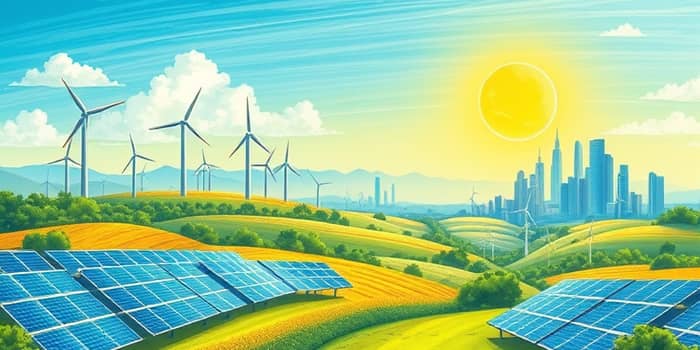
Across continents and industries, the renewable energy sector is experiencing a monumental shift. Fueled by technological breakthroughs, robust policy support, and growing environmental awareness, clean energy is no longer a niche pursuit but a dominant force reshaping the global economy.
From record-breaking capacity expansions to emerging innovations in storage and green hydrogen, the pace of change is staggering. This article explores the forces driving this movement, highlights regional leaders, and examines both the opportunities and challenges that lie ahead.
In 2024, the global renewable energy market was estimated at $1.51 trillion in value, and projections point to $1.60 trillion by 2025. With a compound annual growth rate of 14.9% expected through 2033, the sector stands poised to surpass $4.86 trillion by the end of the decade.
These figures reflect more than mere numbers; they signify a profound transformation in how we power our homes, industries, and cities. Solar and wind installations accounted for over 90% of new capacity additions in 2024, underlining their status as the primary engines of the green revolution.
Photovoltaic solar panels and onshore wind turbines have become the cheapest new-build options for electricity in many regions. Their affordability is underpinned by economies of scale, improved manufacturing processes, and continuous technological advances.
Beyond these cornerstones, several technologies are gaining prominence:
While renewable expansion is a global phenomenon, certain markets have emerged as leaders. In North America, the United States claimed the highest growth potential for 2025, driven by federal incentives and streamlined permitting reforms.
China, by contrast, contributed nearly 64% of new global capacity in 2024, underscoring its central role in manufacturing and deployment. Meanwhile, Australia, Brazil, India, and several emerging economies in Africa and South America are rapidly scaling clean energy projects.
The geographic distribution of growth reveals both promise and disparity. Asia leads the charge, whereas regions like Central America and the Caribbean have yet to fully capitalize on their renewable potential.
Several factors are accelerating the shift to renewables. Government policies and subsidies continue to channel unprecedented investment into energy infrastructure, with over $1.5 trillion expected in 2025 alone.
Reforms in permitting and grid interconnection have unlocked stalled projects, reducing approval times and facilitating faster deployment. Moreover, corporate sustainability commitments—particularly from tech giants and financial institutions—are creating a huge market demand for green power.
Data centers, in particular, have doubled their monitored renewable capacity to over 100 GW in response to surging digital workloads. This trend highlights the interdependence between our digital economy and the clean energy supply chain.
Despite this momentum, the path to a fully decarbonized energy system is fraught with hurdles. Grid modernization remains a critical bottleneck, as aging infrastructure struggles to accommodate variable renewable inputs.
To meet the ambitious goal of tripling renewable capacity by 2030, the industry must sustain a minimum annual growth rate of 16.6%, a target that demands both innovation and unwavering commitment.
Transitioning to renewable energy yields far-reaching benefits beyond carbon reduction. Improvements in air quality could prevent over 13 million premature deaths annually, demonstrating a direct impact on public health and quality of life.
Renewables have also become the most cost-competitive generation source. In 2024, 96% of new solar and wind projects offered electricity at lower costs than existing coal and natural gas plants, fostering more resilient energy markets.
Moreover, decentralized renewable systems empower communities, create local jobs, and build energy independence—fueling economic development alongside environmental stewardship.
Looking forward, innovation in storage technologies will be paramount. Breakthroughs in battery chemistry, recycling, and sustainable sourcing of materials can unlock even greater scalability.
Green hydrogen emerges as a transformative solution for industries that are difficult to electrify. Its commercialization at scale could revolutionize sectors from transportation to manufacturing.
Ultimately, the synergy between corporate ambition, governmental policy, and community engagement will determine the pace of the clean energy revolution. By embracing collaboration and maintaining ambitious targets, humanity can harness the full potential of renewables to create a sustainable, prosperous future.
References













